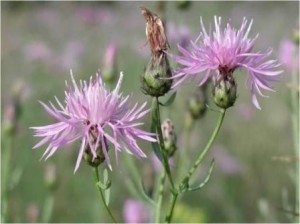Spotted knapweed is a biennial plant native to Eurasia that may occur as spotty to heavy infestations in dry pastures, valleys, southeast facing dry slopes, and roadsides. Spotted knapweed forms a rosette of leaves in its first year of growth, and then develops into a bush-like plant in its second year. It grows in clumps with multiple branches, mostly occurring in the upper portions of the plant. Numerous pinkish composite flowers are formed throughout the second year. It readily invades disturbed sites, choking out native vegetation, and once established, will move into surrounding more pristine areas. Studies have shown that its root system does not hold soil well and that net losses of soil are seen on sites infested with spotted knapweed.
A. Hand Removal:
Pulling or cutting of spotted knapweed can be very effective in removing small patches or inaccessible vegetation from upland areas. Spotted knapweed is very adaptable and grows quickly. In many regions, hand removal alone must be performed more than once in a growing season. Sprouting and regrowth is much less likely if plants are removed after seedhead production but before flowering. Clippers, weed whackers, and hand pulling are applicable for the removal of spotted knapweed.
Most hand removal systems will cut off or otherwise stop seed production of spotted knapweed. If the hand control practices and site chosen are compatible, and the timing is well planned, good to excellent results can be attained in controlling spotted knapweed within five to seven growing seasons.
B.Mowing:
Mowing can be effective in clearing vegetation from upland areas and large infestations. Removal of foliage and prevention of seed set in spotted knapweed will inhibit its ability to produce food and may kill the root stocks. However, in many regions, mowing must be performed more than once a growing season because rootstocks will continue to sprout new growth.
Timing can play an important role in the efficacy of mowing. Plants grow rapidly with the onset of spring, and the first impulse may be to make the site look more maintained. If this is a primary consideration, then mow the site to those specifications, keeping in mind that spotted knapweed will exhibit prostrate growth habits and continue to produce seed. Knapweed reproduces only from seeds, so elimination of seed production is essential, although mowed plants will continue to produce new vegetation from the root. Because knapweed is typically a biennial species, the first year of growth produces only a rosette that will not be impacted by mowing. Seeds are produced only in the second year of growth. In a one-time mowing schedule, the optimum time for mowing is just prior to flowering but after development of the immature seedhead. Mowing at this time allows the plant to exhaust its energy reserves but eliminates seed production. If mowing is late and the seedheads have started to flower they should be collected and removed from or burned onsite to kill any viable seed.
C.Tillage:
Tillage may be effective on sites where soil disturbance is tolerable. In many regions, tillage alone must be performed more than once in a growing season. Most ground tillage systems will cut off, bury, and stop seed production of spotted knapweed. If done correctly at the right time of year, good to excellent results can be attained in controlling spotted knapweed within two to three growing seasons. For example, tillage of knapweed and immediate reseeding of grasses in the fall has been very successful in the Northwest.
D.Herbicides:
Spot spray knapweed with glyphosate or triclopyr. Treat rosettes (first-year growth) or second-year plants during the bud stage just prior to flowering. If necessary, retreat plants in late summer or early fall.
ROUNDUP [glyphosate (41%)]: 2.5 fl. oz./gal
BRUSH-B-GON [triclopyr (8%)]: 4 fl. oz./gal
References
Invasive and Alien Plant Species of Virginia Spotted Knapweed (Centaurea maculosa Lam.). http://www.state.va.us/%7Edcr/dnh/invlist.htm
Noxious and Nuisance Plant Information System, Version 4.0.
Sheley, R.L., J.S. Jacobs, and M.F. Carpinelli. 1998. Distribution, biology, and management of diffuse knapweed (Centaurea diffusa) and spotted knapweed (Centaurea maculosa). Weed Technology 12(2): 353-362.
